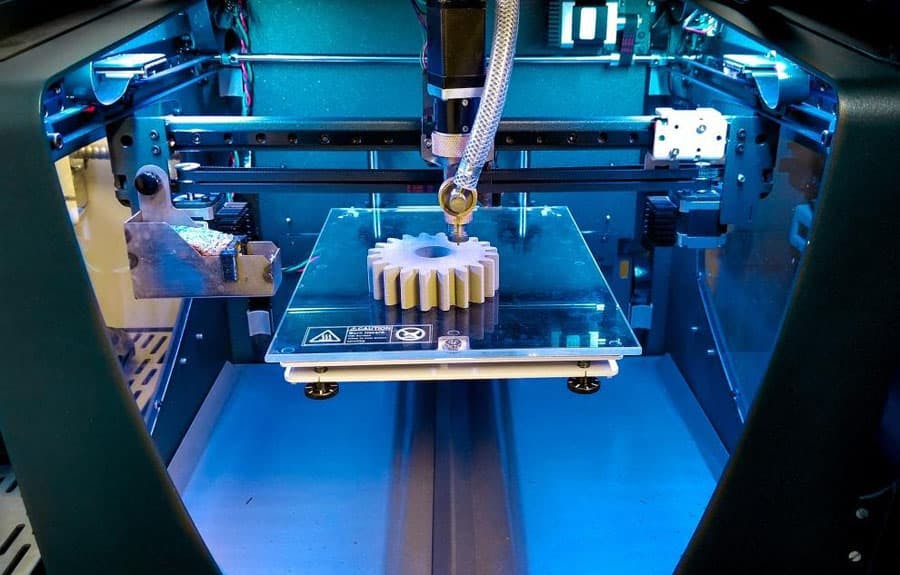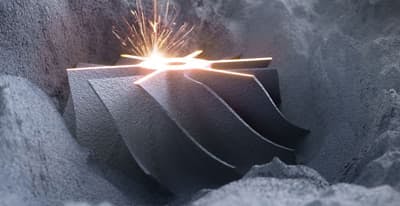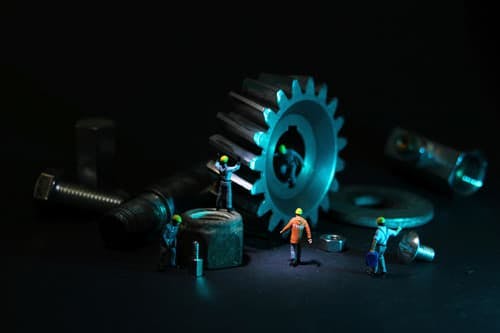What Additive Manufacturing Can Do for Future Industries
Regardless of whether the focus is on lightweight construction, component reduction or the time factor - we show spectacular applications of additive manufacuturing that applied in our life.
Lightweight optimized frame for electric motorcycles
The Premium Aerotec subsidiary AP-Works aims to make aviation technologies usable for industry. For example, it manufactures bionically optimized metal components using selective laser melting (SLS) for users in robotics and automotive engineering. Using the example of an electric motorcycle, AP-Works 2016 showed the possibilities this technology offers. The ready-to-drive prototype weighs 35 kg and travels at up to 120 km/h. The frame weighs just 6 kg - a weight saving of 30% compared to other electric motorcycles in this class. Using topology optimizationand generative design, the best possible structure was determined to absorb the loads that occur while driving. An algorithm was used that works bionic: Natural growth processes determine which load paths are to be implemented more strongly and which less strongly. The result of the optimization is only remotely reminiscent of a motorcycle as we know it. Thanks to advances in the field of additive manufacturing, the bionic construction could be realized unchanged. The frame was built from thousands of 60 µm thin Scalmalloy powder layers. Scalmalloy is a corrosion-resistant aluminum alloy with nearly the specific strength of titanium. Specially made by AP-Works for additive manufacturing developed to combine high strength with a high degree of ductility.
Gas-tight microreactor for molecular determination
Gas chromatographs are essential for the chemical industry to make precise statements about the exact composition of samples. However, precise measurement results can only be obtained if all individual parts of such an instrument are manufactured in such a way that they fulfill their purpose as best as possible - a circumstance that is difficult to achieve with traditional manufacturing methods. This also applied to the microreactor. It is integrated into a gas chromatograph flame ionization detector system and quickly quantifies the carbonaceous chemicals in a sample. One of the most important features of the reactor is that it must also be suitable for gas-tight, high-temperature applications. Under no circumstances should individual molecules of the volatile compounds escape from the finished product, otherwise the desired functionality would not be achieved. The Activated Research Company turned to Protolabs and their 3D printing services to develop and produce the Polyarc microreactor. Together they decided to manufacture using Selective laser melten technology (SLM). The implementation with this method of additive manufacturing allowed the company to accommodate several channels, reaction chambers, a heater and temperature measuring device within the reactor, despite its design in micro resolution of only 50 mm by 25 mm. The Polyarc catalytic microreactor was launched in 2015.
Function-integrated injection head of a rocket engine
“Mission Critical” – a statement that absolutely applies to Class 1 components in the aerospace industry. For this reason, engineers are constantly striving to develop components with the highest quality, functionality and robustness, while simplifying the production chain and reducing the number of individual components. With the help of 3D printing technology from EOS, ArianeGroup has completely redefined this maxim: the injector head of a rocket engine, using the example of a future upper stage engine, now only has one part instead of 248. The injection head was "simplified" in the truest sense of the word. Clever design and manufacturing using selective laser melting (SLM) made it possible, among other things, to cut the 122 injection nozzles, to print the base and front plate as well as the distributor dome with the corresponding supply pipe for the fuels hydrogen and oxygen as an integral component from EOS nickel alloy IN718. Due to the significantly higher productivity of the EOS M 400-4 multi-laser system compared to 3D printers with single lasers, the construction time could be reduced by a factor of 3 and the costs reduced by 50%, using the example of the AiO injection head.
Plastic telescopic structure withstands rocket launch
The "Mini-EUSO" (Multiwavelength Imaging New Instrument for the Extreme Universe Space Observatory) telescope is used to study terrestrial and cosmic UV emissions. The entire mechanical structure was produced using the Stratasys Fortus 450mc FDM printer and is currently on board the ISS (International Space Station). Manufacturing the mechanical structure of Mini-EUSO presented several challenges to the Italian National Research Center Istituto Nazionale di Fisica Nucleare (INFN). Above all, a material was needed that would meet the strict certification requirements of the aerospace industry and the ISS, while at the same time withstanding the mechanical stresses and vibrations of a rocket launch. After a full aluminum prototype failed to achieve the desired results, the plastic ULTEM 9085 Resin emerged as the perfect solution - the material is extremely durable, very light and offers exceptional insulating properties as well as high chemical and thermal resistance. Thus, the safety and weight restrictions of the ISS can be met. By using Stratasys FDM 3D printing throughout the production of the mini-EUSO's mechanical structure, the overall cost of the project was reduced by a factor of ten, while saving about a full year of development time. very light and offers exceptional insulation properties as well as high chemical and thermal resistance. Thus, the safety and weight restrictions of the ISS can be met. By using Stratasys FDM 3D printing throughout the production of the mini-EUSO's mechanical structure, the overall cost of the project was reduced by a factor of ten, while saving about a full year of development time. very light and offers exceptional insulation properties as well as high chemical and thermal resistance. Thus, the safety and weight restrictions of the ISS can be met. By using Stratasys FDM 3D printing throughout the production of the mini-EUSO's mechanical structure, the overall cost of the project was reduced by a factor of ten, while saving about a full year of development time.
Halved delivery time for ICE spare parts
The availability of locomotives and trains plays a key role in rail punctuality. The so-called box link is one of the components relevant to mobility. It ensures safe cornering in the bogie area of ICE trains. Spare parts are not kept, because the box link does not count as a wearing part. However, when two parts failed, the rail supplier Rolf Lenk was given the task of finding a replacement as quickly as possible. A delivery time of ten months had been calculated for conventional casting. Rolf Lenk was convinced of 3D metal printingto be able to deliver much faster with an arc405 from Gefertec. The 3DMP (3D Metal Print) machines work with the WAAM (Wire Arc Additive Manufacturing) process, in which commercially available wire is melted with an arc. Compared to printing with metal powder, the process scores with high process speeds, even with complex component geometries - two decisive factors in this job. Gefertec took over the development of the process parameters using the CAM model programmed by Rolf Lenk. The challenge lay in the interaction of geometry and process. The subsequent loads on the component during use also had to be taken into account. In the end, the two box backdrops could be delivered after just five months instead of the ten months that would otherwise have been required.
Complete electric motor in multi-material printing
In 2018, researchers from the Professorship for Electrical Energy Conversion Systems and Drives at Chemnitz University of Technology succeeded in printing complete electric motors. The 3D multi-material printing process developed for this purpose uses metallic and ceramic pastes, which are shaped in layers by extrusion and then sintered. This meant that all the important components of an electrical machine could be produced in one printing process. These include the copper electrical conductors, which together with iron or ferrous alloys cause the formation and alignment of the magnetic fields, and the ceramic electrical insulation, which insulates the conductors from each other and from the iron parts known as the magnetic circuit. The aim of the research work was to shift the operating temperature of electrical machines above 220 °C. This was achieved by replacing polymer-based insulation materials with special ceramics. In addition to the higher temperature resistance, the ceramic insulation material also has higher thermal conductivity, which means that the power density of electrical machines can also be increased.
Fuel-efficient liquid engine for microlaunchers
You don't need a whole launch vehicle to get small satellites with a payload of up to 350 kg into space. So-called microlaunchers are a good alternative. With the goal of saving 30% fuel, researchers at the Fraunhofer Institute for Material and Beam Technology IWS, together with space experts from the TU Dresden, additively developed, manufactured and tested a light, fuel-saving aerospike engine at the beginning of 2020. The special feature: the fuel injector, combustion chamber and nozzle are manufactured using Laser Powder Bed Fusion (L-PBF). The nozzle itself consists of a spike-shaped central body through which the combustion gases are accelerated. The decisive factor for additive manufacturing was the implementation of conformal cooling with 1mm wide internal cooling channels. The requirements for the metal:
Custom made PTFE parts
PTFE is a high-quality plastic that can withstand high loads and temperatures of up to 300°C. This is exactly what makes processing in the 3D printing process difficult. 3M has therefore developed a new 3D printing process. In the new process, the starting material is already in a liquid state and is hardened step by step using UV radiation. A special light-sensitive binding material is used for this, which is thermally removed after the printing process. Thanks to the new technology, fully fluorinated polymers can be processed for prototypes and small series using 3D printing for the first time.





